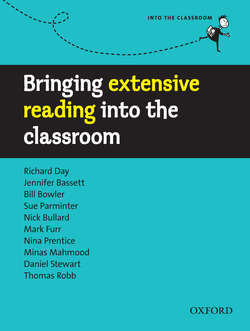Читать книгу Bringing extensive reading into the classroom - Richard Day - Страница 3
На сайте Литреса книга снята с продажи.
Introduction
ОглавлениеExtensive Reading (ER) is becoming an increasingly important component in English language education. Over recent years a wide range of programmes has developed across the world. This growth is no accident, for ER responds to a number of classroom needs.
First, it is an effective way of extending contact with English outside the classroom. Provided appropriately graded materials are used, it gives students the opportunity to see the language they learn in a classroom environment used in the context of communicating something – usually a story. And of all the language learning activities that students can do outside the classroom, ER is perhaps the one they are most likely to do, because it can be fun.
Second, it personalizes students’ contact with the language. By reading the books that they want to read, at a time and place of their choice, ER both individualizes the learning experience and makes it autonomous. Both of these are features that many of us would wish to introduce into the classroom.
Third, reading and writing have often been neglected in language programmes, despite the fact that many students, for study or work, need to develop both skills. Students can only develop the writing (and reading) skills that they need by reading extensively; writing is not a skill that can develop without models.
Finally, and this point emerges time and time again from the chapters in this book, reading can be pleasurable; and anything that associates language learning with pleasure has great value. Even more than that, it is clear that there are many students who have participated in ER programmes and found the experience life-changing.
In his opening chapter, Richard Day defines ER and looks at some evidence of its success in the classroom. His emphasis on the use of graded materials as an essential part of any programme underlies all of this book – there can be no successful ER without appropriately graded materials.
In the next two chapters, editors of two series of graded readers give us their views on how ER materials can be developed and how they see them being used. Jennifer Bassett explains the principles of language grading, stresses the importance of good storytelling, and offers three golden keys to extensive reading – comfort, choice, and enthusiasm. Bill Bowler and Sue Parminter give us some historical background, and look at the development of both graded readers and appropriate support materials.
The next three chapters look at three approaches to ER. Sue Parminter and Bill Bowler look at the use of class readers – often the best way of introducing reading into the classroom. Nick Bullard then looks at libraries, including digital libraries, and how they can provide greater choice and diversity of reading for students. And Mark Furr describes the concept of Reading Circles, which are classroom-based reading and discussion groups that bring Extensive Reading materials into the classroom as core texts for discussion.
The final section of this book introduces four case studies, and these should prove a valuable resource for those who want to embark on an ERP. They look at some of the obstacles and show how these can be surmounted. Nina Prentice in Jordan and Minas Mahmood in Bahrain describe how an ERP can be introduced successfully in government schools. It is clear in these two programmes that the effect on some students has been profound. Daniel Stewart in a private school and Thomas Robb in a university, both in Japan, describe how a programme can be organized within a single institution. They also outline some elegant solutions to the difficulties they encountered.
Two series editors, three approaches to ER, and four case studies of programmes in action – for those who want to introduce ER into their classroom, this book provides the logic for doing so, some possible approaches, and some fine examples of programmes in action.
There are sometimes divergent views or differences in emphasis between the contributions to this volume. This in itself is no bad thing. There is no single ideal approach to ER which fits with every class or every teacher. Teachers need to evaluate these different approaches and judge for themselves what will work best in their own classroom.
